Air Force Space Command
| Air Force Space Command | |
|---|---|
 Shield of Air Force Space Command | |
| Active |
1 September 1982–present (36 years, 1 month) Detailed
|
| Country |
|
| Branch |
|
| Type | Major Command |
| Role | "To provide resilient and affordable space and cyberspace capabilities for the Joint Force and the Nation."[2] |
| Size | 19,944 airmen[3] |
| Part of |
|
| Headquarters | Peterson Air Force Base, Colorado, U.S. |
| Motto(s) | "Guardians of the High Frontier"[4] |
| Decorations |
Air Force Organization Excellence Award[1] |
| Website |
www |
| Commanders | |
| Commander | Gen John W. Raymond[5] |
| Deputy Commander | Maj Gen Robert J. Skinner |
| Command Chief | CCM Brendan I. Criswell |
Air Force Space Command (AFSPC), sometimes referred to informally as U.S. Space Command,[6] is a major command of the United States Air Force, with its headquarters at Peterson Air Force Base, Colorado. AFSPC supports U.S. military operations worldwide through the use of many different types of satellite, launch and cyber operations. Operationally, AFSPC is an Air Force component command subordinate to U.S. Strategic Command (USSTRATCOM), a unified combatant command. It is the primary space force for the U.S. Armed Forces.
More than 38,000 people perform AFSPC missions at 88 locations worldwide; they include military personnel of the Regular Air Force, Air Force Reserve and Air National Guard; Department of the Air Force civilians (DAFC); and civilian military contractors. Composition consists of approximately 22,000 military personnel and 9,000 civilian employees, although their missions overlap.
On 1 December 2009, the strategic nuclear intercontinental ballistic missile (ICBM) mission that AFSPC inherited from Air Combat Command (ACC) in 1993, and which ACC had inherited following the inactivation of Strategic Air Command (SAC) in 1992, was transferred to the newly established Air Force Global Strike Command (AFGSC).[7]
Mission
According to AFSPC, its mission is to "Provide resilient and affordable Space and Cyberspace capabilities for the Joint Force and the Nation."[8] As a result, AFSPC's activities make the space domain reliable to United States warfighters (i.e., combat forces personnel) by assuring their access to space.
AFSPC's primary mission areas are:
- Space forces support, involving the launching of satellites and other high-value payloads into space using a variety of expendable launch vehicles and operating those satellites once in space
- Space control, ensuring the friendly use of space through the conduct of counterspace operations encompassing surveillance, negation, protection and space intelligence analysis[9]
- Force enhancement, providing satellite-based weather, communications, intelligence, missile warning, and navigation; force enhancement is direct support to the warfighter
History
During the Cold War, space operations focused on missile warning and associated command and control for the National Command Authority (NCA). Missile warning operations from the former Aerospace Defense Command (ADC) that had been assumed by Tactical Air Command (TAC) in the late 1970s, and space and spacelift/space launch operations that had been resident in the Air Force Systems Command (AFSC), were combined to form a new Air Force major command (MAJCOM) in 1982 known as Space Command. Following the creation of United States Space Command (USSPACECOM) as a Unified Combatant Command, in 1985, Space Command was renamed Air Force Space Command (AFSPC) and assigned to USSPACECOM as its USAF component command.
In 1991, Operation Desert Storm provided emphasis for AFPSC's new focus on support to the warfighter. ICBM forces previously assigned to the inactivated Strategic Air Command (SAC) were merged into AFSPC in 1993 until moved into Air Force Global Strike Command (AFGSC) in 2009. In August 2009, Air Force Space Command became the lead MAJCOM for all Air Force cyberspace operations with the stand-up of 24th Air Force, gaining Air Force cyber operations and combat communications units, the Air Force Network Integration Center, and the Air Force Spectrum Management Office (formerly known as the Air Force Frequency Management Agency). On 1 April 2013, Air Force Space Command announced that the Space Innovation and Development Center's missions had been realigned under Headquarters, Air Force Space Command, and the Air Force Warfare Center of the Air Combat Command (ACC).[10]
The Space Command was the subject of a 60 Minutes News segment on CBS in April 2015. When speaking with 60 Minutes reporter David Martin, commanding General John E. Hyten was not able to respond to many of the questions, claiming the information was classified but that the program was doing its part in keeping the global world of GPS satellites and other important global satellite usage peaceful. To ensure satellite safety, General Hyten confirmed the belief that other countries were developing anti-satellite technology, but that the Space Command Program was developing technologies of their own, including telescopic lasers to better track the paths of satellites. Reporter David Martin also asked about the new Boeing X-37 spaceplane the US Air Force had been testing. General Hyten confirmed that it could bring satellites into orbit and bring them back, and that the US Air Force would do everything they could to protect the country and its satellites from the danger posed by anti-satellite technology from China and Russia in the future.[11]
In 2016 Space Command began their Space Mission Force concept of operations to respond quickly to attacks in space.[12][13] Each Space Wing undergoes special training then serves a four to six-month rotation.[14]
Launch Service Agreements
In 2016, the US Congress authorized the Air Force to "sign deals with the space industry to co-finance the development of new rocket propulsion systems. The program known as the Launch Service Agreement (LSA) fits the Air Force’s broader goal to get out of the business of 'buying rockets' and instead acquire end-to-end services from companies. The Air Force signed cost-sharing partnerships with [launch vehicle company] ULA, [launch vehicle and rocket engine manufacturers] SpaceX [and] Orbital ATK, and [with rocket engine supplier] Aerojet Rocketdyne. The original request for proposals noted the Air Force wants to 'leverage commercial launch solutions in order to have at least two domestic, commercial launch service providers.' The next step is to select three companies [by mid-year 2018] to move forward with launch system prototypes.", which the Air Force Space and Missile Systems Center intends to award by July 2018.[15]
2018
On July 17, 2018, 24th Air Force, along with the cyber mission, was moved from Air Force Space Command to Air Combat Command.[16]
List of commanders
| No. | Image | Name | Start of Term | End of Term | Notes |
|---|---|---|---|---|---|
| 1. | 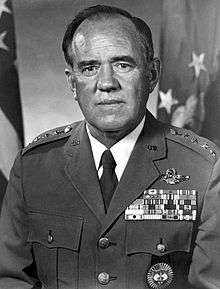 |
Gen James V. Hartinger | 1 September 1982 | 30 July 1984 | [17] |
| 2. | Gen Robert T. Herres | 30 July 1984 | 1 October 1986 | ||
| 3. | Maj Gen Maurice C. Padden | 1 October 1986 | 29 October 1987 | ||
| 4. | 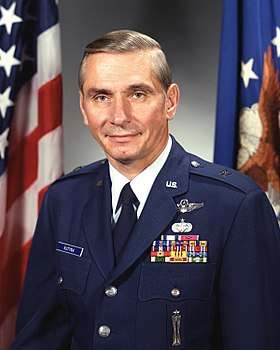 |
Lt Gen Donald J. Kutyna | 29 October 1987 | 29 March 1990 | |
| 5. | 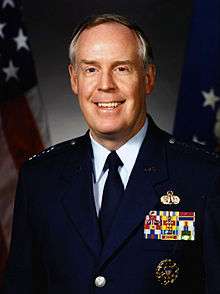 |
Lt Gen Thomas S. Moorman Jr. | 29 March 1990 | 23 March 1992 | |
| 6. |  |
Gen Donald J. Kutyna | 23 March 1992 | 30 June 1992 | |
| 7. | .jpg) |
Gen Charles A. Horner | 30 June 1992 | 13 September 1994 | |
| 8. | 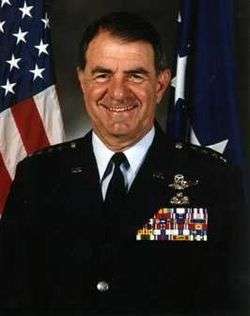 |
Gen Joseph W. Ashy | 13 September 1994 | 26 August 1996 | |
| 9. |  |
Gen Howell M. Estes III | 26 August 1996 | 14 August 1998 | |
| 10. |  |
Gen Richard B. Myers | 14 August 1998 | 22 February 2000 | |
| 11. |  |
Gen Ralph E. Eberhart | 22 February 2000 | 19 April 2002 | |
| 12. | 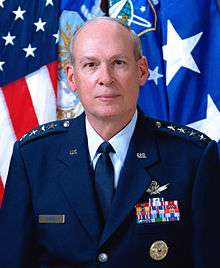 |
Gen Lance W. Lord | 19 April 2002 | 1 April 2006 | |
| Acting |  |
Lt Gen Frank G. Klotz | 1 April 2006 | 26 June 2006 | |
| 13. | 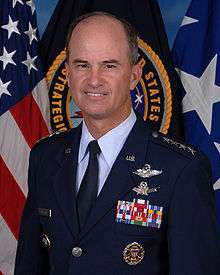 |
Gen Kevin P. Chilton | 26 June 2006 | 3 October 2007 | |
| Acting | Lt Gen Michael A. Hamel | 3 October 2007 | 12 October 2007 | ||
| 14. |  |
Gen C. Robert Kehler | 12 October 2007 | 5 January 2011 | |
| 15. | 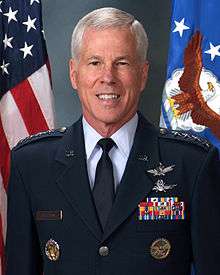 |
Gen William L. Shelton | 5 January 2011 | 15 August 2014 | |
| 16. | Gen John E. Hyten | 15 August 2014 | 25 October 2016 | ||
| 17. | .jpg) |
Gen John W. Raymond | 25 October 2016 | Incumbent |
Organization
Numbered Air Forces
Air Force Space Command has one active Numbered Air Force (NAF).
Fourteenth Air Force
The Fourteenth Air Force (14 AF) provides space warfighting forces to U.S. Strategic Command in its capacity as Air Forces Strategic-Space, and is located at Vandenberg AFB, California. It is responsible for space launch / space lift of payloads from facilities in California and Florida, and manages the generation and employment of space forces to support U.S. Strategic Command and North American Aerospace Defense Command (NORAD) operational plans and missions.[18]
Direct Reporting Units
AFSPC is the major command providing space forces for U.S. Strategic Command. AFSPC also supports NORAD with ballistic missile warning information, operates the Space Warfare Center to develop space applications for direct warfighter support, and is responsible for the U.S. Department of Defense's ICBM follow-on operational test and evaluation program.
Space and Missile Systems Center
The Space and Missile Systems Center (SMC) at Los Angeles AFB, California, designs and acquires all Air Force and most Department of Defense space systems. It oversees launches, completes on-orbit checkouts, then turns systems over to user agencies. It supports the Program Executive Office for Space on the NAVSTAR Global Positioning, Defense Satellite Communications and MILSTAR systems. SMC also supports the Defense Meteorological Satellite Program and the Follow-on Early Warning System. In addition, it supports development and acquisition of land-based intercontinental ballistic missiles for the Air Force Program Executive Office for Strategic Systems.
Locations
The AFSPC headquarters is a major unit located at Peterson AFB, Colorado. There are six AFSPC host bases:
- Buckley AFB, Colorado
- 460th Space Wing
- 233rd Space Group (Colorado Air National Guard)
- Los Angeles AFB, California
- Space and Missile Systems Center
- Global Positioning Systems Directorate
- Space Superiority Systems Directorate
- Launch and Range Systems Directorate
- Space-Based Infrared Systems Directorate
- Defense Weather Systems Directorate
- Military Satellite Communications Systems Directorate
- Space Logistics Directorate
- Missile Defense Systems Directorate
- Space Development and Test Directorate (Kirtland AFB, New Mexico)
- Spacelift Range and Network Systems Division
- 61st Air Base Group
- 61st Civil Engineering and Logistics Squadron
- 61st Medical Squadron
- 61st Mission Support Squadron
- Space and Missile Systems Center
- Patrick AFB and Cape Canaveral AFS, Florida
- Peterson AFB, Colorado
- 21st Space Wing
- 821st Air Base Group (GSU at Thule Air Base, Greenland)
- 20th Space Control Squadron (GSU at Eglin AFB Site C-6, Florida
- 310th Space Wing (AFRC)
- 21st Space Wing
- Schriever AFB, Colorado
- Vandenberg AFB, California
AFSPC also operates several Air Force Stations for launch support and early warning missions:
- Cape Cod Air Force Station, Massachusetts
- Cavalier AFS, North Dakota
- Cheyenne Mountain AFS, Colorado
- Clear Air Force Station, Alaska
- Greeley Air National Guard Station, Colorado
- New Boston AFS, New Hampshire
Space capabilities
Spacelift operations at the East and West Coast launch bases provide services, facilities and range safety control for the conduct of DOD, NASA and commercial launches. Through the command and control of all DOD satellites, satellite operators provide force-multiplying effects—continuous global coverage, low vulnerability and autonomous operations. Satellites provide essential in-theater secure communications, weather and navigational data for ground, air and fleet operations and threat warning. Ground-based radar and Defense Support Program satellites monitor ballistic missile launches around the world to guard against a surprise missile attack on North America. Space surveillance radars provide vital information on the location of satellites and space debris for the nation and the world.
General Shelton has said that in order to protect against attacks, Space Situational Awareness is much more important than additional hardening or armoring of satellites.[19]
As of 2013, Air Force Space Command is considering Space Disaggregation, which would involve replacing a few large multimission satellites with larger numbers of smaller single purpose platforms.[20] This could be used to defend against ASATs, by increasing the number of targets that needed to be attacked.[21]
Resources
Satellites
Launch vehicles
Space situational awareness
Ballistic missile warning radars
- AN/FPS-115 PAVE PAWS
- AN/FPS-108 Cobra Dane
- AN/FPQ-16 Perimeter Acquisition Radar Characterization System (PARCS)
- Sea-based X-band Radar Sea-Based X-Band Radar
- Ballistic Missile Early Warning System (BMEWS)
In popular culture
In the science-fiction TV series Stargate SG-1, Stargate Atlantis, and Stargate Universe the fictional Stargate Program is managed by the U.S. Air Force, specifically through Air Force Space Command.
See also
Comparable organizations
References
- 1 2 http://www.afhra.af.mil/About-Us/Fact-Sheets/Display/Article/433549/air-force-space-command-usaf/
- ↑ http://www.afspc.af.mil/About-Us/Heritage/
- ↑ http://www.airforcemag.com/magazinearchive/magazine%20documents/2017/june%202017/0617grudoallfactsfigures.pdf
- ↑ "Air Force Space Command Heritage". Air Force Space Command. Archived from the original on 22 March 2014. Retrieved 21 March 2014.
- ↑ http://www.afspc.af.mil/About-Us/Biographies/
- ↑ https://www.cbsnews.com/news/space-defense-inside-colorado-cheyenne-mountain-air-force-station/
- ↑ Air Force Space Command: About Us Archived 3 February 2015 at the Wayback Machine.
- ↑ US Air Force. "Air Force Space Command". AFSPC. Archived from the original on 4 April 2014. Retrieved 28 February 2014.
- ↑ Brown, Peter J. (9 July 2009). "Mixed signals over Chinese missiles". Asia Times Online. Retrieved 3 April 2013.
- ↑ "AFSPC Public Web Site". Archived from the original on 23 April 2013. Retrieved 1 April 2013.
- ↑ "The Battle Above, part two". CBS News. CBS Interactive Inc. Retrieved 7 May 2015.
- ↑ "Details of Space Mission Force now available from AF Space Command". www.afspc.af.mil. AFSPC. 15 July 2016. Retrieved 1 October 2016.
- ↑ Prigg, Mark (25 July 2016). "Top Guns in orbit: US Air Force reveals plan for 'Space Mission Force' to protect America using satellites". www.dailymail.co.uk. Daily Mail. Retrieved 1 October 2016.
- ↑ Gruss, Mike (20 July 2016). "U.S. Air Force expands space warfare training". spacenews.com. spacenews.com. Retrieved 17 October 2016.
- ↑
- ↑ "24th Air Force joins Air Combat Command, welcomes new commander". U.S. Air Force. Retrieved 2018-08-14.
- ↑ "2011 USAF Almanac" (PDF). Air Force Magazine. May 2011. p. 105. Retrieved 3 April 2013.
- ↑ "14th Air Force (Air Forces Strategic)". Vandenberg Air Force Base website. United States Air Force. Archived from the original on 21 April 2013. Retrieved 3 April 2013.
- ↑ "Future of USAF Space Command". Defense News. 30 September 2012. Archived from the original on 2 October 2012. Retrieved 3 April 2013.
- ↑ "Disaggregation in Space: A Strategy for National Security Space in an Era of Fiscal Austerity?". George Marshall Institute. Retrieved 3 April 2013.
- ↑ "Space: Disruptive Challenges" (PDF). Air University. Retrieved 3 April 2013.
![]()
External links
- "Air Force Space Command Fact Sheet". Air Force Space Command. August 2015. Archived from the original on 3 March 2016.
- "Air Force Space Command Fact Sheet". Air Force. April 2003. Archived from the original on 24 June 2003.
